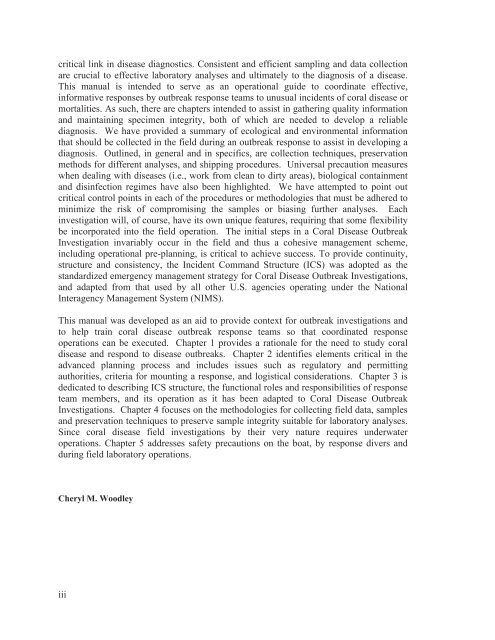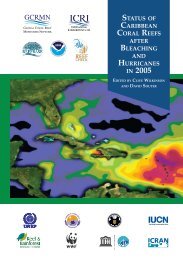critical link in disease diagnostics. Consistent and efficient sampling and data collectionare crucial to effective laboratory analyses and ultimately to <strong>the</strong> diagnosis <strong>of</strong> a disease.This manual is intended to serve as an operational guide to coordinate effective,in<strong>for</strong>mative responses by outbreak response teams to unusual incidents <strong>of</strong> coral disease ormortalities. As such, <strong>the</strong>re are chapters intended to assist in ga<strong>the</strong>ring quality in<strong>for</strong>mationand maintaining specimen integrity, both <strong>of</strong> which are needed to develop a reliablediagnosis. We have provided a summary <strong>of</strong> ecological and environmental in<strong>for</strong>mationthat should be collected in <strong>the</strong> field during an outbreak response to assist in developing adiagnosis. Outlined, in general and in specifics, are collection techniques, preservationmethods <strong>for</strong> different analyses, and shipping procedures. Universal precaution measureswhen dealing with diseases (i.e., work from clean to dirty areas), biological containmentand disinfection regimes have also been highlighted. We have attempted to point outcritical control points in each <strong>of</strong> <strong>the</strong> procedures or methodologies that must be adhered tominimize <strong>the</strong> risk <strong>of</strong> compromising <strong>the</strong> samples or biasing fur<strong>the</strong>r analyses. Eachinvestigation will, <strong>of</strong> course, have its own unique features, requiring that some flexibilitybe incorporated into <strong>the</strong> field operation. The initial steps in a <strong>Coral</strong> <strong>Disease</strong> Outbreak<strong>Investigation</strong> invariably occur in <strong>the</strong> field and thus a cohesive management scheme,including operational pre-planning, is critical to achieve success. To provide continuity,structure and consistency, <strong>the</strong> Incident Command Structure (ICS) was adopted as <strong>the</strong>standardized emergency management strategy <strong>for</strong> <strong>Coral</strong> <strong>Disease</strong> Outbreak <strong>Investigation</strong>s,and adapted from that used by all o<strong>the</strong>r U.S. agencies operating under <strong>the</strong> NationalInteragency Management System (NIMS).This manual was developed as an aid to provide context <strong>for</strong> outbreak investigations andto help train coral disease outbreak response teams so that coordinated responseoperations can be executed. Chapter 1 provides a rationale <strong>for</strong> <strong>the</strong> need to study coraldisease and respond to disease outbreaks. Chapter 2 identifies elements critical in <strong>the</strong>advanced planning process and includes issues such as regulatory and permittingauthorities, criteria <strong>for</strong> mounting a response, and logistical considerations. Chapter 3 isdedicated to describing ICS structure, <strong>the</strong> functional roles and responsibilities <strong>of</strong> responseteam members, and its operation as it has been adapted to <strong>Coral</strong> <strong>Disease</strong> Outbreak<strong>Investigation</strong>s. Chapter 4 focuses on <strong>the</strong> methodologies <strong>for</strong> collecting field data, samplesand preservation techniques to preserve sample integrity suitable <strong>for</strong> laboratory analyses.Since coral disease field investigations by <strong>the</strong>ir very nature requires underwateroperations. Chapter 5 addresses safety precautions on <strong>the</strong> boat, by response divers andduring field laboratory operations.Cheryl M. Woodleyiii
ACKNOWLEDGMENTSWe would like to acknowledge <strong>the</strong> contributions <strong>of</strong> <strong>the</strong> following methods and protocols <strong>for</strong> inclusion inthis manual:Microbiology Collection Protocols <strong>for</strong> <strong>the</strong> <strong>Field</strong> by Drs. Kay Marano-Briggs, Robert B. Jonas and CherylM. WoodleyContaminant and toxicology protocols in this manual were adapted, with permission, from World WildlifeFund (WWF) manual: "Sampling, Biomarker, and Contaminant Chemical Target Analyte ProtocolsAssessing <strong>the</strong> Effectiveness <strong>of</strong> Agricultural Better Management Practices in <strong>the</strong> Mesoamerican Reef"written by Craig A. Downs, Haereticus Environmental Laboratory and Melanie Mc<strong>Field</strong>, WWF andMesoamerican Alliance <strong>of</strong> <strong>the</strong> International <strong>Coral</strong> Reef Action Network. 60p. (Downs 2005b)Dr. Shawn McLaughlin, curator <strong>of</strong> <strong>the</strong> International Registry <strong>of</strong> <strong>Coral</strong> Pathology, and scientist at <strong>the</strong>NOAA NOS Ox<strong>for</strong>d, MD Laboratory and Ms. Kathy Price, <strong>for</strong>mally <strong>of</strong> <strong>the</strong> NOAA NOS Ox<strong>for</strong>dLaboratory provided histology protocols, CITES in<strong>for</strong>mation and shipping protocols.Dr. Es<strong>the</strong>r Peters supplied protocols <strong>for</strong> fixation <strong>of</strong> corals <strong>for</strong> histological analysis.Accompanying instructional videos, Histology Laboratory Protocols: <strong>Coral</strong> and Collection Techniques <strong>for</strong><strong>Coral</strong> <strong>Disease</strong> Outbreak <strong>Investigation</strong>s were post-production edited by Ms. Dorothy Howard, ASCP <strong>of</strong> <strong>the</strong>NOAA NOS Ox<strong>for</strong>d, MD Laboratory, who went beyond her normal laboratory duties because <strong>of</strong> <strong>the</strong>passion she has to contribute to our understanding <strong>of</strong> disease processes in coral and educating <strong>the</strong> nextgeneration <strong>of</strong> investigators.We thank Ms. Kathy Price <strong>for</strong> hosting <strong>the</strong> Histology Laboratory Protocols: <strong>Coral</strong> video and providing <strong>the</strong>content and demonstration <strong>of</strong> laboratory procedures <strong>for</strong> coral histology and we thank Ms. Dorothy Howardas <strong>the</strong> videographer.For <strong>the</strong> Collection Techniques <strong>for</strong> <strong>Coral</strong> <strong>Disease</strong> Outbreak <strong>Investigation</strong>s video, we appreciate <strong>the</strong>contributions by members <strong>of</strong> <strong>the</strong> Woodley Laboratory, Julie Higgins, Mats Lundqvist, Sara Polson, andShawn Polson <strong>for</strong> <strong>the</strong>ir input to <strong>the</strong> storyboard <strong>for</strong> <strong>the</strong> video and <strong>the</strong>ir contributions to <strong>the</strong> numerousrevisions. We are indebted to <strong>the</strong> National Park Service’s Biscayne National Park and Richard Curry <strong>for</strong>providing <strong>the</strong> logistics, location and divers <strong>for</strong> filming. Herve Jobert, an intern with Biscayne NationalPark from Florida Institute <strong>of</strong> Technology provided surface support. We especially thank Larry Murphy,Chief <strong>of</strong> <strong>the</strong> NPS’s Submerged Resources Center <strong>for</strong> making it possible <strong>for</strong> <strong>the</strong> underwater videographythrough <strong>the</strong> expertise <strong>of</strong> camera man, Brett Seymour, who gave us beautiful High Definition Video footage.It is with much appreciation we recognize <strong>the</strong> time, ef<strong>for</strong>ts and field experience <strong>of</strong> Dr. Margaret W. Miller<strong>of</strong> NOAA’s National Marine Fisheries Service, Sou<strong>the</strong>ast Fisheries Science Center, Miami Laboratory andDr. Dana E. Williams <strong>of</strong> <strong>the</strong> University <strong>of</strong> Miami Rosenstiel School <strong>of</strong> Marine and Atmospheric Science,Cooperative Institute <strong>for</strong> Marine and Atmospheric Studies who helped to develop and refine <strong>the</strong> content <strong>of</strong>each <strong>of</strong> <strong>the</strong> scenes demonstrating <strong>the</strong> underwater techniques <strong>of</strong> collecting biopsies from corals and practicaltechniques to handling and containing potentially infectious materials. We appreciate <strong>the</strong> work <strong>of</strong> Dr. MatsLundqvist, NOAA National Ocean Service, Charleston, SC Laboratory who demonstrated <strong>the</strong> top-sideprocedures <strong>for</strong> sampling handling, stabilization, labeling and preservation as well as culture-dependentmicrobiology procedures that are conducted in <strong>the</strong> field laboratory. We also thank Dan Diresta, University<strong>of</strong> Miami who demonstrated top-side support and transport activities. We would like to especially thankDr. Robert Jonas <strong>for</strong> providing an in<strong>for</strong>mative addition to <strong>the</strong> latest edition <strong>of</strong> this video on Processing<strong>Coral</strong> Tissue <strong>for</strong> Microbiological Analyses.iv
- Page 2 and 3: DisclaimerThe contents of this docu
- Page 5: PREFACECoral reefs throughout their
- Page 9: CHAPTER 4 CASE HISTORY, SAMPLE COLL
- Page 12 and 13: diseases, however, remain elusive a
- Page 16 and 17: species of interest or manifesting
- Page 18 and 19: statistically significant and biolo
- Page 20 and 21: 2.2 Regulatory AuthorityThe Respons
- Page 22 and 23: Review and assist in development of
- Page 24 and 25: familiar with such protocols, and w
- Page 26 and 27: incident operations. The IC sets pr
- Page 28 and 29: Sampling Kits: Pre-assembled kits w
- Page 30 and 31: Chapter 3Incident Command System3.1
- Page 32 and 33: 3.4 ICS Roles and Responsibilities3
- Page 34 and 35: 3.5 Establishing a Command/Operatio
- Page 36 and 37: Coral Disease Investigation Decisio
- Page 38 and 39: zooxanthellae), or completely absen
- Page 40 and 41: 3.6.4 Launching an Investigation: L
- Page 42 and 43: Chapter 4Case History, Sample Colle
- Page 44 and 45: 4.4 Survey Team- Site Identificatio
- Page 46 and 47: site, complexity of the reef, and e
- Page 48 and 49: 4.4.3.2 Possible Modifications to C
- Page 50 and 51: 4.4.5 Field Microscopy4.4.5.1 Intro
- Page 52 and 53: 4.4.5.3 Use of Stereo MicroscopeThe
- Page 54 and 55: Collection Form, and will ferry tim
- Page 56 and 57:
Due to time sensitivity of some sam
- Page 58 and 59:
protein chemistry based and include
- Page 60 and 61:
Tissue for Microbiology (H-B, U-B,
- Page 62 and 63:
When shipping coral samples from ou
- Page 64 and 65:
4.10.2 MicrobiologyMicrobiology is
- Page 66 and 67:
Chapter 5Health and Safety5.1 Safet
- Page 68 and 69:
5.4 Precautions in the FieldCoral H
- Page 70 and 71:
Glossary of TermsBleaching: Loss or
- Page 72 and 73:
mortality rates); the apparent occu
- Page 74 and 75:
Knowlton, N. 2001. The future of co
- Page 76 and 77:
66Appendices
- Page 78 and 79:
Appendix II.Level I Data - Coral Di
- Page 80 and 81:
Level II Data: Coral Disease Event
- Page 82 and 83:
Appendix V. Support Team Processing
- Page 85 and 86:
Appendix VII.DocumentsCollection Pe
- Page 87 and 88:
called a Common Main Objective (CMO
- Page 89 and 90:
With reasonable care stereo microsc
- Page 91:
United States Department of Commerc
















